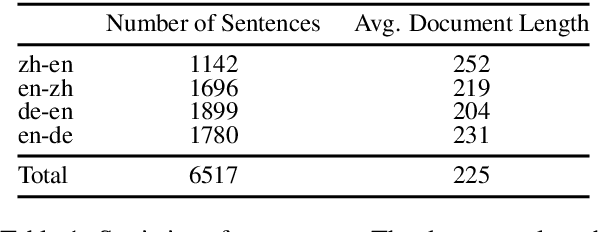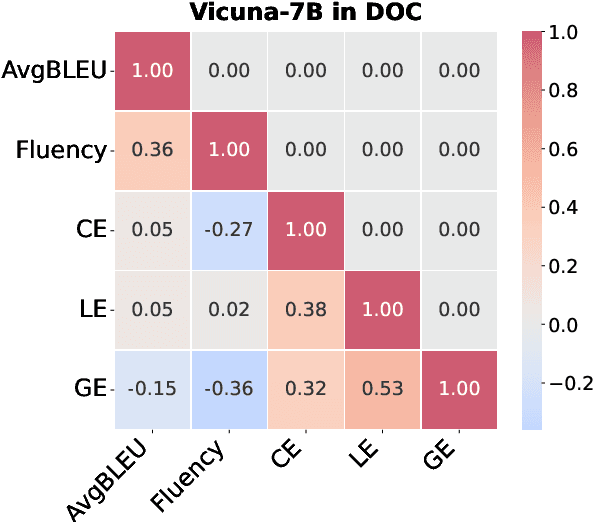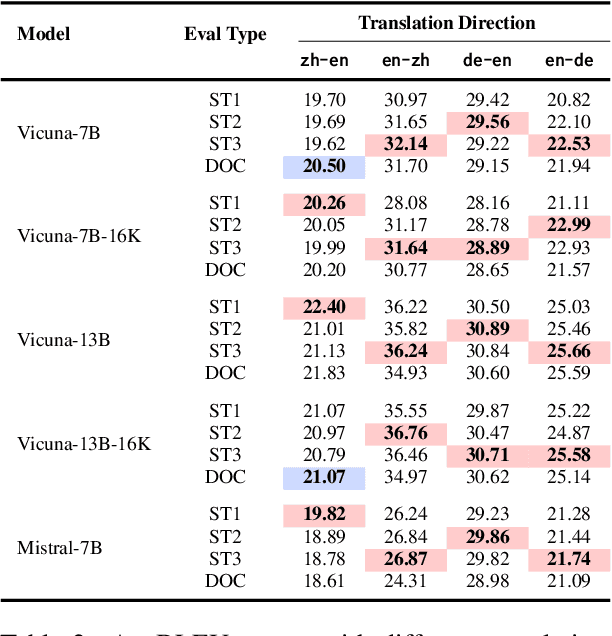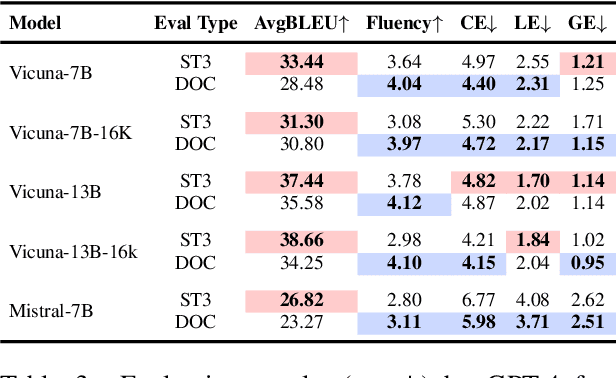Dawei Zhu
Chain-of-Thought Matters: Improving Long-Context Language Models with Reasoning Path Supervision
Feb 28, 2025Abstract:Recent advances in Large Language Models (LLMs) have highlighted the challenge of handling long-context tasks, where models need to reason over extensive input contexts to aggregate target information. While Chain-of-Thought (CoT) prompting has shown promise for multi-step reasoning, its effectiveness for long-context scenarios remains underexplored. Through systematic investigation across diverse tasks, we demonstrate that CoT's benefits generalize across most long-context scenarios and amplify with increasing context length. Motivated by this critical observation, we propose LongRePS, a process-supervised framework that teaches models to generate high-quality reasoning paths for enhanced long-context performance. Our framework incorporates a self-sampling mechanism to bootstrap reasoning paths and a novel quality assessment protocol specifically designed for long-context scenarios. Experimental results on various long-context benchmarks demonstrate the effectiveness of our approach, achieving significant improvements over outcome supervision baselines on both in-domain tasks (+13.6/+3.8 points for LLaMA/Qwen on MuSiQue) and cross-domain generalization (+9.3/+8.1 points on average across diverse QA tasks). Our code, data and trained models are made public to facilitate future research.
LongAttn: Selecting Long-context Training Data via Token-level Attention
Feb 24, 2025Abstract:With the development of large language models (LLMs), there has been an increasing need for significant advancements in handling long contexts. To enhance long-context capabilities, constructing high-quality training data with long-range dependencies is crucial. Existing methods to select long-context data often rely on sentence-level analysis, which can be greatly optimized in both performance and efficiency. In this paper, we propose a novel token-level framework, LongAttn, which leverages the self-attention mechanism of LLMs to measure the long-range dependencies for the data. By calculating token-level dependency strength and distribution uniformity of token scores, LongAttn effectively quantifies long-range dependencies, enabling more accurate and efficient data selection. We filter LongABC-32K from open-source long-context datasets (ArXiv, Book, and Code). Through our comprehensive experiments, LongAttn has demonstrated its excellent effectiveness, scalability, and efficiency. To facilitate future research in long-context data, we released our code and the high-quality long-context training data LongABC-32K.
MMTEB: Massive Multilingual Text Embedding Benchmark
Feb 19, 2025Abstract:Text embeddings are typically evaluated on a limited set of tasks, which are constrained by language, domain, and task diversity. To address these limitations and provide a more comprehensive evaluation, we introduce the Massive Multilingual Text Embedding Benchmark (MMTEB) - a large-scale, community-driven expansion of MTEB, covering over 500 quality-controlled evaluation tasks across 250+ languages. MMTEB includes a diverse set of challenging, novel tasks such as instruction following, long-document retrieval, and code retrieval, representing the largest multilingual collection of evaluation tasks for embedding models to date. Using this collection, we develop several highly multilingual benchmarks, which we use to evaluate a representative set of models. We find that while large language models (LLMs) with billions of parameters can achieve state-of-the-art performance on certain language subsets and task categories, the best-performing publicly available model is multilingual-e5-large-instruct with only 560 million parameters. To facilitate accessibility and reduce computational cost, we introduce a novel downsampling method based on inter-task correlation, ensuring a diverse selection while preserving relative model rankings. Furthermore, we optimize tasks such as retrieval by sampling hard negatives, creating smaller but effective splits. These optimizations allow us to introduce benchmarks that drastically reduce computational demands. For instance, our newly introduced zero-shot English benchmark maintains a ranking order similar to the full-scale version but at a fraction of the computational cost.
AFRIDOC-MT: Document-level MT Corpus for African Languages
Jan 10, 2025



Abstract:This paper introduces AFRIDOC-MT, a document-level multi-parallel translation dataset covering English and five African languages: Amharic, Hausa, Swahili, Yor\`ub\'a, and Zulu. The dataset comprises 334 health and 271 information technology news documents, all human-translated from English to these languages. We conduct document-level translation benchmark experiments by evaluating neural machine translation (NMT) models and large language models (LLMs) for translations between English and these languages, at both the sentence and pseudo-document levels. These outputs are realigned to form complete documents for evaluation. Our results indicate that NLLB-200 achieved the best average performance among the standard NMT models, while GPT-4o outperformed general-purpose LLMs. Fine-tuning selected models led to substantial performance gains, but models trained on sentences struggled to generalize effectively to longer documents. Furthermore, our analysis reveals that some LLMs exhibit issues such as under-generation, repetition of words or phrases, and off-target translations, especially for African languages.
More Tokens, Lower Precision: Towards the Optimal Token-Precision Trade-off in KV Cache Compression
Dec 17, 2024Abstract:As large language models (LLMs) process increasing context windows, the memory usage of KV cache has become a critical bottleneck during inference. The mainstream KV compression methods, including KV pruning and KV quantization, primarily focus on either token or precision dimension and seldom explore the efficiency of their combination. In this paper, we comprehensively investigate the token-precision trade-off in KV cache compression. Experiments demonstrate that storing more tokens in the KV cache with lower precision, i.e., quantized pruning, can significantly enhance the long-context performance of LLMs. Furthermore, in-depth analysis regarding token-precision trade-off from a series of key aspects exhibit that, quantized pruning achieves substantial improvements in retrieval-related tasks and consistently performs well across varying input lengths. Moreover, quantized pruning demonstrates notable stability across different KV pruning methods, quantization strategies, and model scales. These findings provide valuable insights into the token-precision trade-off in KV cache compression. We plan to release our code in the near future.
Instruction-Tuned LLMs Succeed in Document-Level MT Without Fine-Tuning -- But BLEU Turns a Blind Eye
Oct 29, 2024



Abstract:Large language models (LLMs) have excelled in various NLP tasks, including machine translation (MT), yet most studies focus on sentence-level translation. This work investigates the inherent capability of instruction-tuned LLMs for document-level translation (docMT). Unlike prior approaches that require specialized techniques, we evaluate LLMs by directly prompting them to translate entire documents in a single pass. Our results show that this method improves translation quality compared to translating sentences separately, even without document-level fine-tuning. However, this advantage is not reflected in BLEU scores, which often favor sentence-based translations. We propose using the LLM-as-a-judge paradigm for evaluation, where GPT-4 is used to assess document coherence, accuracy, and fluency in a more nuanced way than n-gram-based metrics. Overall, our work demonstrates that instruction-tuned LLMs can effectively leverage document context for translation. However, we caution against using BLEU scores for evaluating docMT, as they often provide misleading outcomes, failing to capture the quality of document-level translation. Code and data are available at https://github.com/EIT-NLP/BLEUless_DocMT
AgentBank: Towards Generalized LLM Agents via Fine-Tuning on 50000+ Interaction Trajectories
Oct 10, 2024



Abstract:Fine-tuning on agent-environment interaction trajectory data holds significant promise for surfacing generalized agent capabilities in open-source large language models (LLMs). In this work, we introduce AgentBank, by far the largest trajectory tuning data collection featuring more than 50k diverse high-quality interaction trajectories which comprises 16 tasks covering five distinct agent skill dimensions. Leveraging a novel annotation pipeline, we are able to scale the annotated trajectories and generate a trajectory dataset with minimized difficulty bias. Furthermore, we fine-tune LLMs on AgentBank to get a series of agent models, Samoyed. Our comparative experiments demonstrate the effectiveness of scaling the interaction trajectory data to acquire generalized agent capabilities. Additional studies also reveal some key observations regarding trajectory tuning and agent skill generalization.
To Preserve or To Compress: An In-Depth Study of Connector Selection in Multimodal Large Language Models
Oct 09, 2024



Abstract:In recent years, multimodal large language models (MLLMs) have garnered significant attention from both industry and academia. However, there is still considerable debate on constructing MLLM architectures, particularly regarding the selection of appropriate connectors for perception tasks of varying granularities. This paper systematically investigates the impact of connectors on MLLM performance. Specifically, we classify connectors into feature-preserving and feature-compressing types. Utilizing a unified classification standard, we categorize sub-tasks from three comprehensive benchmarks, MMBench, MME, and SEED-Bench, into three task types: coarse-grained perception, fine-grained perception, and reasoning, and evaluate the performance. Our findings reveal that feature-preserving connectors excel in \emph{fine-grained perception} tasks due to their ability to retain detailed visual information. In contrast, feature-compressing connectors, while less effective in fine-grained perception tasks, offer significant speed advantages and perform comparably in \emph{coarse-grained perception} and \emph{reasoning} tasks. These insights are crucial for guiding MLLM architecture design and advancing the optimization of MLLM architectures.
The Accuracy Paradox in RLHF: When Better Reward Models Don't Yield Better Language Models
Oct 09, 2024Abstract:Reinforcement Learning from Human Feedback significantly enhances Natural Language Processing by aligning language models with human expectations. A critical factor in this alignment is the strength of reward models used during training. This study explores whether stronger reward models invariably lead to better language models. In this paper, through experiments on relevance, factuality, and completeness tasks using the QA-FEEDBACK dataset and reward models based on Longformer, we uncover a surprising paradox: language models trained with moderately accurate reward models outperform those guided by highly accurate ones. This challenges the widely held belief that stronger reward models always lead to better language models, and opens up new avenues for future research into the key factors driving model performance and how to choose the most suitable reward models. Code and additional details are available at [https://github.com/EIT-NLP/AccuracyParadox-RLHF](https://github.com/EIT-NLP/AccuracyParadox-RLHF).
From Calculation to Adjudication: Examining LLM judges on Mathematical Reasoning Tasks
Sep 06, 2024Abstract:To reduce the need for human annotations, large language models (LLMs) have been proposed as judges of the quality of other candidate models. LLM judges are typically evaluated by measuring the correlation with human judgments on generation tasks such as summarization or machine translation. In contrast, we study LLM judges on mathematical reasoning tasks. These tasks require multi-step reasoning, and the correctness of their solutions is verifiable, enabling a more objective evaluation. We perform a detailed performance analysis and find that the used judges are mostly unable to improve task performance but are able to pick the better model. Our analysis uncovers a strong correlation between judgment performance and the candidate model task performance. We observe that judges tend to choose the model of higher quality even if its answer is incorrect. Further, we show that it is possible to use statistics, such as the task performances of the individual models, to predict judgment performance. In an ablation, we either swap or mask the candidate answers and observe that judges often keep the original judgment, providing evidence that judges incorporate writing style in their judgments. In summary, we find that regularities in the judgments are quantifiable using statistical measures and provide various angles on exploiting them.
 Add to Chrome
Add to Chrome Add to Firefox
Add to Firefox Add to Edge
Add to Edge